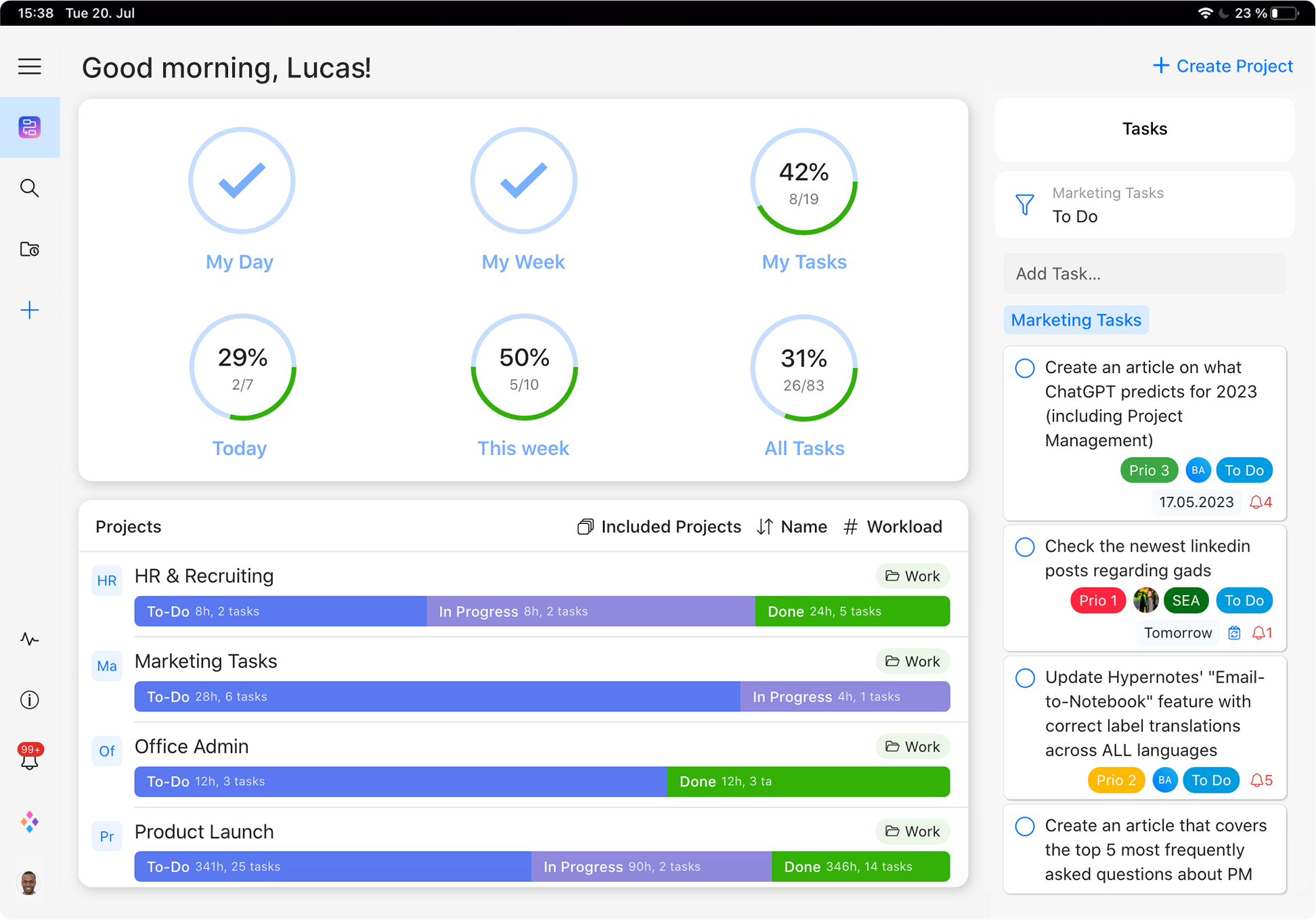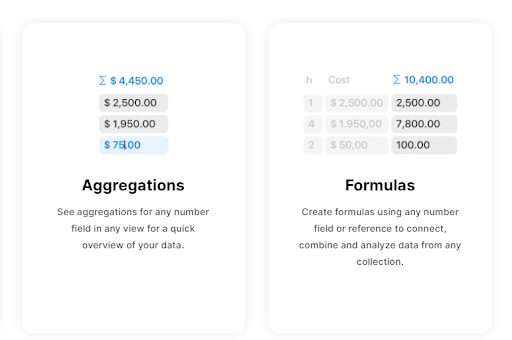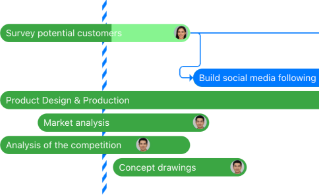
Managing a project budget can be one of the most challenging aspects of project management. Without a solid plan, costs can spiral, deadlines can be missed, and the overall success of the project may be jeopardized. The stakes are high, but so are the opportunities to excel when equipped with the right strategies.
A well-crafted budget not only ensures your project stays financially on track but also builds confidence among stakeholders and sets the stage for outstanding results.
By following practical, proven methods, you can avoid common pitfalls, control costs, and even identify opportunities for savings.
What you’ll learn in this article:
✅ How to identify project tasks and accurately determine your budget needs
✅ Strategies to track expenses and adapt to unexpected changes effectively
✅ Ways to review and refine your budget process for future projects
How to successfully manage your Project Budget
1. Identify your tasks and what you’ll need
The cornerstone of a successful project budget is accurately identifying your project tasks and requirements. Tasks are actionable units of work tied directly to your project’s objectives and timeline. A comprehensive approach to identifying these tasks ensures you set realistic expectations and allocate your budget efficiently.
Start with a detailed Needs Assessment
A thorough project needs assessment is essential. This process involves defining the project’s scope, goals, deliverables, and resource requirements. It serves as a foundation for your project plan and budget. Beyond setting objectives, the assessment clarifies which tasks are critical and what resources—human, technical, or material—are necessary to achieve them.
Engaging stakeholders and team members during this phase fosters alignment and minimizes surprises later. Collaboration ensures the project scope is well-defined, which is crucial for precise budgeting and scheduling.
Break down your tasks
Breaking your project into manageable tasks is key to staying on track. Tasks should be specific, actionable, and directly aligned with project goals. For instance, if your project involves launching an email marketing campaign, your task list might look like this:
- Automate email drips
- Write compelling email copy
- Design visually appealing graphics
- Verify and segment the email list
This granular breakdown ensures no detail is overlooked, making it easier to forecast costs accurately.
Prioritize requirements strategically
Organize your tasks and resource needs by priority. This not only helps streamline the budget but also allows you to focus on delivering the most impactful results first. For example, when Vodafone embarked on a complex network transition, they began with team workshops to clearly define priorities and project scope. By identifying critical needs upfront, they delivered results ahead of schedule while optimizing costs.

Discover the ultimate project management tool.
Sign up for free today!
2. Create an estimate and get it approved
Once you’ve identified your project tasks and requirements, the next crucial step is creating a detailed cost estimate. Accurate cost estimation lays the foundation for budget approval and successful project execution. Here’s how to refine the process for better outcomes:
Break down your costs
Start by evaluating the cost of each task, factoring in both direct and indirect expenses. Consider:
- Time requirements: How long will each deliverable take to complete?
- Resource costs: Equipment, software, and personnel
- Human resources: Salaries or fees for freelancers, consultants, and subcontractors
- Contingency funds: Extra funds for unexpected changes or risks
For instance, in the email marketing campaign, costs may include:
- Subscription to an email marketing platform
- Hiring a freelance copywriter and graphic designer
- Tools for email verification and segmentation
Ensure your estimates are as accurate as possible by using actual figures, market data, and industry benchmarks. Avoid relying on guesses, as incorrect estimates can erode project margins, delay timelines, and impact overall quality.
Use proven Estimation Techniques
Leverage established techniques to create reliable cost estimates. Here are a few effective methods:
- Bottom-Up Estimating: Break down tasks into smaller components, estimate each, and sum them up for a total
- Expert Judgment: Consult team members or specialists who have experience with similar tasks
- Analogous Estimating: Use data from similar past projects as a benchmark, adjusting for current market conditions
These methods ensure your estimates are grounded in realistic projections.
Engage vendors and compare prices
If your project relies on external vendors or service providers, take the time to gather quotes and compare options. Use freelance platforms, social media networks, or direct outreach to potential partners. Comparing multiple bids ensures you secure competitive rates and gain a clearer picture of potential costs.
Pro Tip: If referencing previous projects, account for inflation or market shifts. For example, software licensing fees or contractor rates may have increased since your last similar project.
Prepare for approval
Once your estimate is complete, prepare it for client or management approval. This involves:
- Clear documentation: Include a breakdown of costs with supporting details for transparency
- Avoid jargon: Use simple, accessible language to explain the figures and rationale
- Supplementary materials: Attach any vendor quotes, benchmarks, or cost calculation frameworks used to arrive at your totals
This clarity helps decision-makers quickly understand how the budget aligns with the project’s scope and objectives, expediting the approval process.
Add contingency and flexibility
Ensure your estimate includes a contingency fund to cover unforeseen costs. Industry standards often recommend setting aside 5-15% of the total budget for contingencies, depending on the project’s complexity.

3. Use a budget tracker
Once your project budget is approved and all preparatory steps are completed, the next critical step is ensuring you stay on track financially. This is where a budget tracker becomes indispensable. Effective budget tracking allows you to monitor expenses in real-time and address potential overruns before they escalate.
Why Budget Tracking matters
Research indicates that only 43% of organizations consistently complete projects within budget. Without a reliable tracking mechanism, costs can spiral out of control, leading to missed deadlines, reduced quality, and dissatisfied stakeholders. Budget tracking acts as an early warning system, helping you identify and resolve spending issues before they disrupt your project.
Choose the right Budget Tracking Tools
There are several ways to track your budget, from simple spreadsheets to sophisticated project management software. Consider the following options:
- Spreadsheets: Tools like Excel or Google Sheets are cost-effective and flexible for smaller projects. Use formulas to automate calculations and compare actual costs with estimates.
- Project Management Software: For complex projects, tools like Zenkit allow you to track expenses alongside task progress. Many platforms offer integration with financial tools, enabling seamless data sharing.
Monitor costs in Real-Time
Budget tracking involves more than simply recording expenses. It requires a proactive approach to comparing your original estimates with actual expenditures as the project unfolds. Real-time tracking offers several benefits:
- Identify cost overruns early: Spot discrepancies and adjust your spending before they impact the overall budget
- Uncover hidden costs: Complex projects often have unforeseen expenses. Tracking helps you stay aware and allocate resources accordingly
- Maintain stakeholder confidence: Regular updates on budget adherence reassure clients and management of your project’s financial health
Implement Budget Alerts
Many tracking tools offer automation features such as budget alerts. Set thresholds for spending, so you’re notified immediately if costs approach or exceed predefined limits. These alerts help you react quickly and make informed decisions.
Analyze trends and adjust
Budget tracking isn’t just about oversight—it’s also a learning opportunity. By analyzing trends during the project, you can identify patterns in spending and adjust your strategy. For example:
- If certain tasks consistently exceed budget, investigate whether the issue stems from inaccurate estimates or inefficiencies
- Reallocate resources from under-budget areas to cover overruns without requiring additional funding
Communicate with stakeholders
Transparency is key when managing project budgets. Share budget reports with stakeholders regularly to keep them informed about financial progress. Many project management tools allow you to generate visual reports or dashboards for quick and easy updates.
A budget tracker is essential for ensuring that your project stays within financial limits. By combining the right tools, real-time monitoring, and proactive communication, you can prevent cost overruns and achieve project success.
4. Create a process for budget changes
While it’s ideal to adhere to your original project budget, unforeseen events and evolving project demands often make changes unavoidable. Research reveals that 52% of projects completed within 12 months experience uncontrolled changes, also known as scope creep. These unplanned additions—whether new features, tasks, or adjustments—can disrupt your budget if not managed properly.
Understand why changes happen
Scope creep or budget changes can result from several factors, including:
- Adjustments to project objectives
- Errors or gaps in the initial requirements
- Adoption of new technologies
- Continuous improvement efforts or iterative processes
Recognizing these potential triggers helps you anticipate and prepare for changes before they affect your budget.
Develop a Change Management process
Establishing a clear process for managing budget changes ensures they are handled efficiently and transparently. Here’s how to create an effective process:
- Define a change approval workflow: Specify how change requests will be evaluated and approved
- Assign roles and responsibilities: Clearly identify who is responsible for assessing, approving, and implementing changes
- Evaluate the impact: Analyze how proposed changes will affect the project timeline, deliverables, and budget
- Document every change: Record all changes and their rationale to maintain transparency and accountability
For example, designate a Change Control Board (CCB) or a similar team to oversee the evaluation and approval of all major budget adjustments.
Communicate changes effectively
Changes can create confusion if not communicated properly. Ensure that your team and stakeholders are informed promptly about approved changes. Transparency minimizes misunderstandings and maintains trust.
Pro Tip: Use tools like Zenchat to document and share updates in real time, ensuring that everyone stays aligned.
Key benefits of a Budget Change Process
Implementing a structured approach to budget changes ensures:
- Consistency: All changes are handled according to a standardized process
- Clarity: Everyone involved understands their roles and the project’s financial adjustments
- Control: You minimize the risk of uncontrolled spending and scope creep
By proactively managing budget changes, you not only safeguard your project’s financial health but also strengthen stakeholder confidence in your ability to adapt while staying on track.

5. Review and learn from your project budget report
Regularly reviewing your project budget report is essential for keeping your project on track and identifying opportunities for improvement. A well-maintained budget report provides a clear snapshot of your project’s financial performance, ensuring you stay informed and make data-driven decisions.
Track progress throughout the project
Your budget report serves as a living document, offering real-time insights into key financial aspects, such as:
- Cost impediments: Highlighting any unexpected expenses or challenges
- Expenditures: Monitoring how much of the budget has been spent to date
- Available budget: Evaluating whether remaining funds are sufficient for the rest of the project timeline
Consistently updating and reviewing this report ensures that you can quickly address issues before they escalate and adjust resource allocation as needed.
Conduct a Final Review post-project
The end of your project is an ideal time to thoroughly review your budget report. This post-project analysis helps you determine how effectively your team managed the budget and provides actionable insights for future projects. Key areas to assess include:
- Accuracy of initial estimates: Were your original cost estimates realistic?
- Effectiveness of spending controls: How well did the team adhere to the approved budget?
- Areas for improvement: Identify inefficiencies or recurring issues that impacted the budget
For instance, the Asian Development Bank discovered through a budget review that while their expenditure controls were effective, they needed better strategies for managing public spending and clearing financial delays. This analysis directly informed improvements for future project management processes.
Analyze trends and take notes for future projects
Budget reviews are more than just a retrospective—they are a roadmap for improvement. Use your findings to:
- Identify patterns in budget performance, such as common causes of overruns or savings
- Refine your cost estimation techniques and contingency planning for future projects
- Develop benchmarks to compare performance across multiple projects
This proactive learning approach ensures your organization continually evolves and strengthens its financial management practices.
Engage stakeholders in the process
Involve stakeholders in the budget review process to foster transparency and alignment. Sharing insights from the report helps build trust and ensures everyone has a clear understanding of what went well and what can be improved.
Make budget reporting a Best Practice
A strong reporting process doesn’t just benefit the current project—it sets the stage for success in future initiatives. By recording and reviewing your budget report consistently, you:
- Gain better control over project finances
- Learn from past mistakes and successes
- Build a foundation for better decision-making in future projects

Final Thoughts
Mastering project budget management is a cornerstone of project success and a surefire way to build trust with stakeholders. A well-planned and managed budget not only keeps your project on track but also ensures efficient use of resources, leading to better outcomes and increased stakeholder satisfaction.
In this article, we’ve outlined five actionable strategies to help you create and manage your project budget effectively:
- Identify project tasks and needs: Start with a clear scope and resource requirements
- Create an estimate and get approval: Build a detailed, realistic budget and secure stakeholder buy-in
- Use a budget tracker: Monitor expenses in real-time to identify and resolve cost issues early
- Develop a process for budget changes: Establish a structured approach to adapt to scope changes without compromising the budget
- Review and learn from your budget report: Use budget reviews as a tool for continuous improvement in future projects
By implementing these tips, you can ensure your project stays within budget, minimize cost overruns, and even identify opportunities for savings. Adopting modern tools and fostering collaboration with your team will further enhance your budget management capabilities.
Effective budget management is about creating a roadmap for success that supports your team, meets stakeholder expectations, and positions your projects for long-term success. Start applying these strategies today to elevate your project management skills and deliver consistently outstanding results.
Until next time,
The Zenkit Team





Leave a Reply